Monoprice Monolith 13 THX
Monoprice has another hit on their hands, the Monolith 13 is an absolute gem. When I tested the sealed M15-S a few years ago I concluded “the Monoprice Monolith M15-S is a winner” and I have no intention of backing off that now, the company has struck gold again. I really like this subwoofer, it delivers the goods no matter what you throw at it. Monoprice is clearly on a roll, the team behind the Monolith line deserves a raise for a job well done (did I say that before?).
WE LIKE
WE DON'T LIKE
- Authoritative bass, masters movies
- Composed sound even maxed out
- Solid build, handles high output
- Basic looks, generic style
- Can be tough to wake from standby
- Large and heavy, hard to move
WE LIKE
- Authoritative bass, masters movies
- Composed sound even maxed out
- Solid build, handles high output
WE DON'T LIKE
- Basic looks, generic style
- Can be tough to wake from standby
- Large and heavy, hard to move
Specifications for this model are:
- Weight: 153 pounds
- Dimensions: 23.8″ x 20.3″ x 28.1″ (HWD)
- Amp capacity: 2000 watts RMS, 3800 watts peak
- Inputs: 2x RCA, 1x XLR
- Outputs: 1x XLR
- Driver Material: 2 layer long fiber pulp/glass fiber cone
- Surround: NBR (nitrile butadiene rubber)
- Magnet: Ceramic Y35, 2 pieces, 300 oz. total
- Basket: Cast aluminum, 6 spokes
- Frequency response: Extended EQ 16-200Hz (2 or 3 ports); 19-200Hz (2 ports), 20-200Hz (sealed, 3 ports)
- Finish: Black Ash
Ordering Your MonoPrice Monolith 13
Monoprice is a somewhat typical ID (Internet Direct) company. I say “somewhat” because in addition to being able to buy product directly from their website they also have an Amazon store. The price is the same either way so there’s no obvious advantage to buying from one location or the other.
The Monolith 13 retails for $1,550 ($1549.99 actually, but what’s a penny between friends?). Monoprice backs their subwoofer with a 5 year replacement warranty and 30 day money back guarantee. Shipping is free for those in the continental US.
Packaging
“2” is the operative word for packing. The Monoprice Monolith 13 comes in 2 boxes, both of which are 2 layers. 2 inch foam cradles the entire top and bottom of the subwoofer. Thick full-height vertical cardboard sleeves shore up the corners, further preventing crushing loads from causing any damage in transit. If that’s not enough there are V shaped cardboard pieces that cap those, one in each of the 8 corners (4 on top, 4 on the bottom). Think Monoprice knows how brutal UPS and FedEx can be?
Once you get through all the protection you’ll find the subwoofer inside a nice drawstring cloth bag. Monoprice includes white gloves to use while installing the Monolith, probably a bit unnecessary given the matte wood grain finish but it’s a thoughtful touch nonetheless. The grill is separated from the subwoofer, placed inside its own bag made from some type of felt material. Cutouts in the foam keep it away from the cabinet during shipping.
“6” is another operative word for Monoprice; the Monolith 13 has 6 rubber feet, there are 6 magnetic standoffs to hold the grill in place and it comes with a 6′ power cord. What you won’t find in the box is any type of owners manual. However, one can be downloaded in PDF format at this link.
Impressions
You want a first impression that will turn into a lasting one, a harbinger of sorts? Place the Monolith 13 in your location of choice and take off the grill. Don’t even plug the thing in, just take a moment to gaze upon the driver.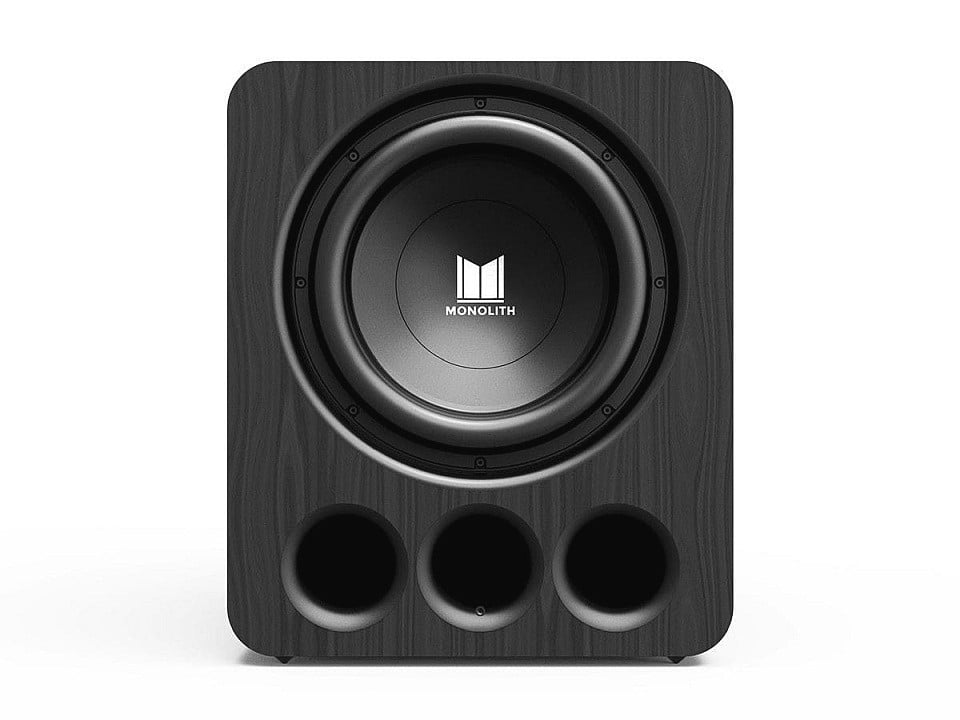
“Menacing” is the first word that comes to mind. How something looks doesn’t always indicate what it can do of course but I don’t care at this point, I’ll find out soon enough if it’s a poser or if that thing is really as formidable as it appears. Is it a prelude of coming attractions or false hope? Not sure, but right now it just looks bad you-know-what. This driver sports one of the largest half roll surrounds I have seen. Initially I thought that was why it looked unusually large, but was it merely an optical illusion? It got to the point where I went and grabbed a tape measure to see how big it really was. In so doing I found something a bit unexpected.
It’s not uncommon for a manufacturer to quote a driver size based upon a measurement which includes the mounting ring. That means a 15″ driver has a cone/surround diameter closer to 13″ instead. When I measured the diameter of the Monolith driver I got 13.5″, if I included the mounting ring it was 15.5″. That explains why it looked bigger to me but that doesn’t explain why Monoprice is, for all intents and purposes, short changing themselves. They could probably sell this as a 15″ woofer and I don’t think anybody would complain. Add to the oversized driver triple 3.5″ front-firing ports and the Monoprice Monolith 13 certainly looks the part. Internally those ports run the full length of the cabinet then turn upwards, extending about 2/3rds of the total height.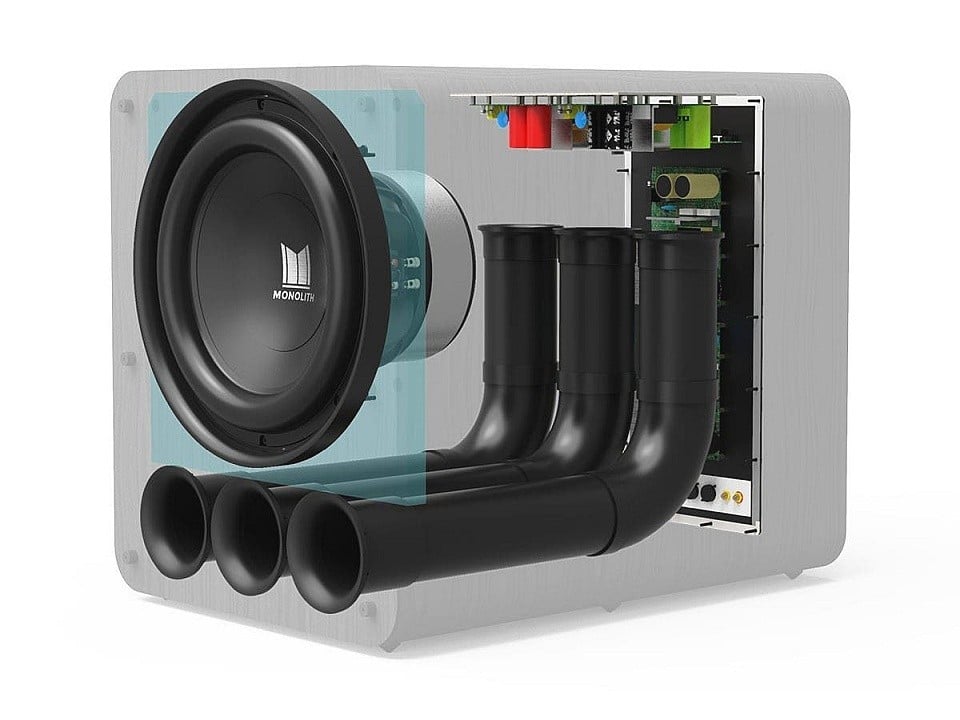
They certainly do the trick as you’ll find out in the Listening section below.
The cabinet is a thing to behold. Neither tall nor wide, viewed from the front it doesn’t seem the least bit imposing. Slide off center and look again and you notice it is quite deep, about 2 1/2 feet. That gives it some presence. It’s as though you bred a dachshund with a rottweiler. Quite a stretch, I know, but work with me here. I’m trying to create a visual.
Made from HDF (High Density Fiberboard) – as opposed to MDF (Medium Density Fiberboard), which most other companies use – the Monolith 13 feels substantial, weighing in at a little over 150 pounds. For those in the UK that’s close to 11 stone. Contributing to the solid feel are internal panel and corner braces. Want an inert structure to minimize cabinet resonance? Apparently you aren’t alone, it seems Monoprice does as well. The interior cabinet walls are lined with acoustic damping material, further deadening the structure.
Running somewhat counter to the bullet-proof persona are the feet. Although there are 6 of them, clearly sufficient given the depth, they aren’t as impressive as the rest of the package. Have you ever seen a monster truck in transit? To clear bridges and remain within Federal guidelines for vehicle height and width they’re transported on trailers with regular (street sized) tires. I’ve seen this in person and it’s a rather odd sight, a hulking vehicle with a 1,500 horsepower nitromethane feed motor adorned with dinky tires.

In daily use the Monolith’s feet proved up to the task but it did seem rather curious to me; massive driver, massive cabinet, massive ports, not so massive feet.
Returning to the theme of solid, the grill is made from 3/4th’s of an inch HDF. It’s finished in smooth black paint with a transparent material stretched uniformly across it. There’s no flex in this thing, like most of the sub it exudes substance. Magnets are strong and the grill snaps firmly into place. At no point did it come off during testing no matter how much I pushed the volume.
The amp plate takes up about half of the back panel, impressive given the size of the enclosure.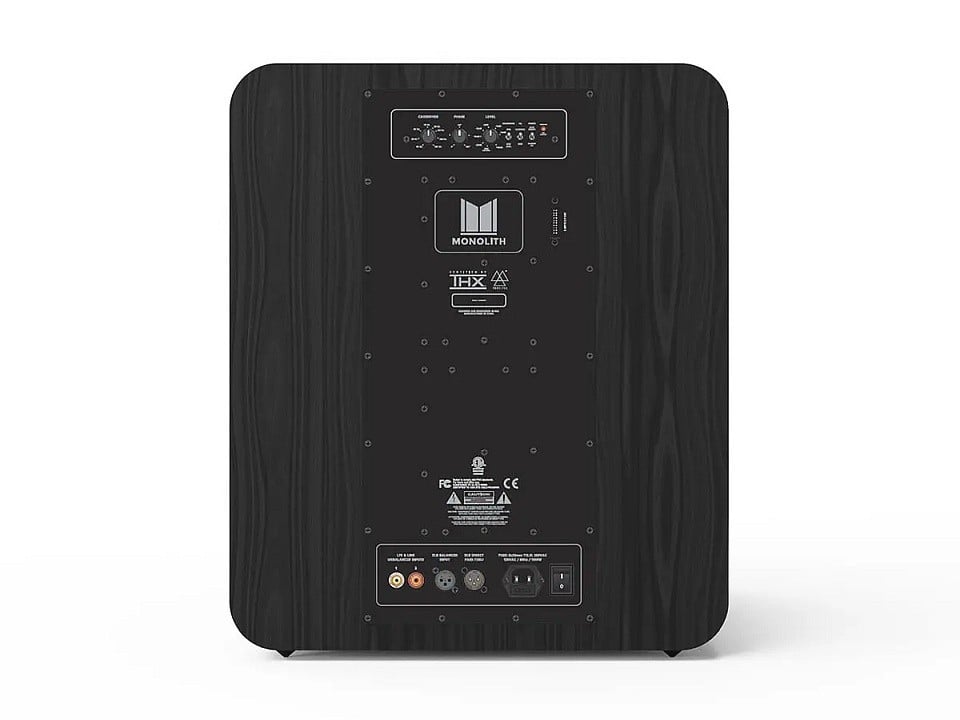
Along the top edge are dials for crossover, phase and volume. Crossover points are clearly marked and delineated in 10Hz increments from 40-90Hz, with settings for 140Hz and 160Hz as well. Phase is 0°, 90° and 180°, with dots to denote 45° and 135°. Volume has a THX setting along with -20dB, -18dB, -12dB, -6dB, 0dB, +6dB and +15dB. In addition to the dials there are toggle switches for the crossover, which is On or Off/THX, along with the EQ setting of either Extended or THX. There’s also the power mode which is Always On or Auto. Along the bottom you’ll find 2 unbalanced inputs for LFE and line-in along with a pair of XLR, one for input and the other pass thru. In the center you’ll find the service port. All of it is logically laid out with legible markings.
I want to circle back to the cabinet for a moment, specifically its appearance. There’s nothing inherently wrong with the Monoprice Monolith 13 – it’s very classy and contemporary – but it looks like… well, like every other subwoofer. Black veneer, rounded edges, smooth finish. I only mention this because a few years back I reviewed one of the previous Monolith models, the sealed M15-S (which I absolutely loved), and at that time Monoprice distanced themselves from the crowd by wrapping their tech in a distinctive cabinet. The horizontal and vertical panels were joined by a small section that had sharp 45 degree angled corners. Although it could be deemed a subtle design cue it nonetheless made them stand out in a crowded field of look-alike products. Everybody knows that beauty is in the eye of the beholder, and almost everyone knows I’m drawn to that which is different, but to me the previous version of the Monolith cabinet gave Monoprice a unique character. Isn’t that the goal of every manufacturer, to draw attention to their products? Being uncommon often does it.
While I’m in a me-centric mood let me tell you about another pet peeve of mine; standby mode. If a subwoofer doesn’t wake up easily and stay on for the entire time I’ve muted the incessant stream of mindless commercials the cable company tries to stuff down my throat it’s going to feel my wrath. Well guess what Monoprice, your Monolith 13 never went into standby no matter how long the commercial break was. Thank you for that. Once it’s gone into hibernation though it does require more volume to rouse from slumber than it probably should. Does that sound like I’m being picky now? If so it’s because you don’t know what the rest of the article is going to say, but I do. From here on out it’s almost exclusively glowing praise – because this subwoofer is really that darn good – so I felt compelled to grouse about something in order to prevent people from accusing me of being a Monoprice sycophant. The engineering team who created this subwoofer should get a bonus, not the last time you’ll hear me say something like that. Read on to find out why.
Listening to the Monoprice Monolith 13
Have you ever heard somebody say “appearances are deceiving”? The beastly driver and the rather deep cabinet could suggest the Monolith 13 is little more than a mauler, and it can play that role very well, but it was able to be refined too. If you’re doing little more than watching TV it was content to hang back, blend into the scenery. It wasn’t invisible by any means, just not conspicuous. But in reality it was lying in wait, similar to a thoroughbred this thing wants to run. Care to have some fun? You know, crank the volume on a movie with a ferocious soundtrack? Maybe have a demo session with your friends and show them select scenes from the most savage flicks you have? Knock yourself out, it absolutely loves to play that game. I don’t particularly like subs that shout “look at me” all the time, I prefer the team player. Rich, clean and smooth during everyday use but able to pack a mean right hook when provoked. Like I said, appearances are deceiving. The Monolith 13 looks like a brute, and when called upon it surely is, but in the end it proved itself to be a faithful companion no matter the situation.
There are two primary modes of operation, Extended and THX. The latter is a rarity in the world of subwoofers. Awarded THX Ultra certification, the second highest of four levels, the Monoprice Monolith 13 has proven to be capable of handling rooms up to 3000 cubic feet. That’s a sizable space, think along the lines of 19’x20’x8′. It’s not only the amount of space it can handle that earns a product THX certification, it also means it passed rigorous tests designed to ensure both accuracy and low distortion even when played at elevated volume levels. There are few companies who’ve achieved THX certification. I’m not sure if the test is costly, other companies products are not able to fulfill the requirements, they aren’t interested in submitting them or perhaps something else. Whatever the reason, I think Monoprice should be commended for allowing their subwoofers to be judged by a 3rd party organization. To me it says they have so much confidence in what they built that they aren’t afraid to put them under a microscope. I wonder if getting a passing grade got the folks who designed this thing a raise. See, I said it again.
I tried both Extended and THX mode for periods of time but when it came to the actual evaluation I mostly went with Extended. Why? For one simple reason, it’s lower F3 is 16Hz compared to 19Hz for THX. I have a smallish room – measuring 13’x17’x8′ – so gain would likely mitigate the difference, but hey I like numbers too. Placebo affect? Could be. For subwoofers wearing a THX badge you will often see a variance in their frequency response between the different modes. The reason is in order to achieve certification you have to play clean and loud. To ensure the latter doesn’t impact the former most engineers will bring up the F3 a few dB. Those really low frequencies are very tough to reproduce at volume, which means distortion can creep in as the driver is pushed closer to its limit. Trim a bit off the bottom and that alleviates the problem. Unless your room is very large – and as such provides little gain – you can run in THX mode and reasonably expect the same type of performance as Extended provides. For me I only push the output when testing a product, the rest of the time it’s at a moderate level, so the lower response was more in line with my personal preferences.
While not used in this review I did play the Edge of Tomorrow opening scene several times to find out how angry I could make the Monolith. There are probably few reading this who don’t know about that 10 or so seconds of pulsing/crippling/merciless bass that happens in the very beginning. Sadistic ploy by the sound engineers? Perhaps, but a reviewers best friend. Despite being short in duration it’s long of reputation. You want to stress test a sub this is for you. I have never had a single one pass with flying colors, every subwoofer I’ve tried it on has complained in some manner. The Monolith 13 is no exception; this was the only time I heard any objectionable noise from the ports.
Because I don’t want to damage any product in my care, something this soundtrack might actually be able to do, I always start with the volume at a medium level and work my way up. On the first pass I get close and listen for distress, using that as a gauge to determine how far I’m going to push it going forward. The Monolith didn’t seem the least bit disturbed initially so I ticked up the volume more than I normally would and went back to my seat for round two. This time it sprang to life and blew waves of air out the ports so powerful that it felt as though a fan was pointed directly at me, and that’s with me being about 14′ feet from the front of the cabinet. Not sure I would enjoy that happening every time I watched an action flick, but I did find it amusing enough to do it about another half a dozen times. Hey, don’t judge.
Movies & TV
When choosing which movies to use while evaluating something I typically try to envision the target audience. Who is going to buy this product and what type of entertainment would they be inclined to watch? I have my staples of course, go-to movies and scenes, but I don’t want to be predictable. That’s boring, when you read my articles I want you to be surprised. So how should I test something like the Monolith 13? There has to be at least one punishing soundtrack because you don’t own something like this if all you want is restraint. But what if I selected things where subtlety was required? Does anyone buy a subwoofer like this expecting fidelity? If it was able to accomplish that would it simply be fortuitous? Monoprice has plenty of reviews that focus on how crazy their subwoofers can get, how far they can be pushed. I’ll go in a different direction, let’s see how it handles every day life.
Tears of the Sun
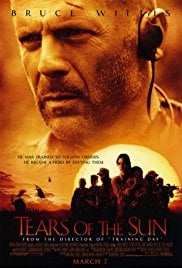
Bruce Willis stars as Lieutenant A.K. Waters, a Navy SEAL commander on assignment in Nigerian sent to find and extricate Lena Kendricks. Dr. Kendricks is at a remote Catholic mission tending to victims of the Nigerian civil war. Due to the highly unstable political situation the US Government has ordered all their citizens out of the country and it’s Waters job to ensure she’s escorted safely to Cameroon.
While trekking through a remote valley the SEAL’s end up crossing paths with a rebel force that significantly outnumbers them. The bad guys launch an attack and rain mortars down on the SEAL’s, causing the Monolith 13 to spring into action about as fast as the Special Forces did. Each time a mortar detonated my floor rumbled from the force, a satisfying wave of bass sent directly my way. The SEAL’s respond with grenades, automatic weapons, hand guns, even a LAW’s rocket. This scene lasts for several minutes and is utter pandemonium, yet despite the intensity the Monolith clearly portrayed every element. It was easy to distinguish the impact of a hand grenade from the pop of an automatic weapon, making for quite an enjoyable experience. You know what, I think I’ll watch that again. Turns out this was not the last time I was so enthralled by what I heard that I rewatched a few scenes.
Den of Thieves

I’ve seen this one mentioned on various forums as having a pretty good soundtrack so I picked up a copy to use as test. I hadn’t even previewed it when the time came to write this evaluation so I’ll have to watch the entire thing to see where the most difficult parts are. Afterwards I come to find it’s not a “bass fest” at all, but at the end things definitely heat up so that’s the part I’ll use.
Gerard Butler plays “big” Nick O’Brien, a burnt out heavy drinking cop who works in an elite crime fighting unit of the Los Angeles County Sheriff’s Department. Similar to Nick Nolte’s Jack Cates character in the movie 48 Hours, both men are in fractured relationships, smoke incessantly and are well on their way to cirrhosis (a fictional character named Nick and the real name of someone who played a similar character?). Unlike Cates however, O’Brien is as shady as some of the folks he arrests. Nick is on the hunt for Ray Merrimen, an ex-Marine who’s also an ex-con. Ray has teamed up with several former military buddies to assemble their own crime ring. Their next heist? To steal millions from the Federal Reserve. As you expect in a film such as this the good guy and the bad guy face off at the end, although in this case it’s the not-so-good guy versus the bad guy. When the Sheriff’s department finally catches up to Merrimen and his crew they’re stuck in traffic (this is LA after all). Time to take notes as I’m assuming this is where things get wild.
The bad guys realize the law is closing in on them so they exit their vehicle armed to the teeth and ready to do battle. There’s a deep rumbling from the soundtrack that heralds the fact something unpleasant is about to happen. The Monolith obliged and growled menacingly, creating the exact effect I would want at this point. There’s some significant hardware at play here, including automatic weapons, so it’s clear things are about to get serious. It isn’t long before all heck breaks loose.
As good and evil battle each other their respective weapons had a solid kick, being both clean and sharp. At various points there was a foreboding undertone element in the soundtrack. I’m not sure exactly what it was but there’s no question the Monoprice Monolith 13 wanted you to know it was there. Unlike Tears of the Sun no one here is packing grenades, RPG’s or mortars, but like Tears the distinction between weapons was very evident. After knowing who was shooting what you could almost close your eyes and use only your ears to determine who each of the trigger men was. I actually had to watch the last 2 scenes twice because I got caught up in the action and stopped writing notes. At the end of the day that’s exactly what you want from a home theater system, to draw you right into the action.
Cloverfield

Rob Hawkins is taking a job overseas so his friends throw him a going-away party. In the middle of the festivities they hear a massive explosion so everyone heads to the roof of the apartment building to get a better view of what’s going on. When they get there another blast occurs, and like the people in the movie it certainly made me notice. Now I’m paying attention and as it turns out the Monolith is only warming up. The second explosion causes everyone to head back inside and run down the steps toward the street. Enroute something else detonates and it was more powerful than the explosion that happened while everyone was on the rooftop. Things are beginning to heat up.
Once the party goers get to the street they’re greeted by countless other like-minded people all milling about trying to figure out what’s going on. A few blocks away they spy some type of massive creature disappearing around the corner but before they can figure out what it was a building starts to collapse. As it crumbles to the ground the Monoprice Monolith 13 began growling ominously, creating an intense rumbling. So powerful was it that a noticeable breeze from the ports could be felt from across the room as the driver pumped out prodigious amounts of bass. Yup, fan effect part two. The Monolith wasn’t done however, it had one more trick up its sleeve.
The rubble and dust cloud from the destroyed building starts to engulf everyone so they scatter, some of whom hole up inside a small store. As they try to regroup the gigantic beast they spied earlier lumbers past and his footsteps send shock waves into my room, creating a palpable sensation in the process. I’m liking this.
Similar to the previous movies, Cloverfield showed how the Monolith could not only punch hard but was also able to jab when the situation called for it. The different elements of each scene were distinct, lending to the realism. As I turned up the volume it just got louder and more impactful, seemingly having extra in reserve each time I upped the ante.
Once the testing had concluded I checked the amp to see if it was hot but it was little more than warm. Regardless of how extreme things got the Monoprice Monolith 13 seemed totally unfazed.
Music
Conventional wisdom holds that you use a sealed subwoofer for a 2 channel music system and ported for a HT setup. The Monoprice Monolith 13 can be configured either way, so you could technically switch back and forth, but there’s probably little reason to do so. With the advent of digital signal processing (DSP) in amplifiers, finite element analysis (FEA) simulation technology and advanced materials the distinction between ported and sealed has been blurred. As such I never really used the Monolith in sealed mode, even for this part of the assessment. It was ported all the way. I basically dropped it into place, ran room correction, adjusted to personal taste and off I went. Some might question why a reviewer wouldn’t tinker – and I did, just to see what the various options provided – but how many people do that in their own home? On forums the percentage of owners prone to fiddling is pretty high, but outside of that realm? The number is a lot smaller so I tried to emulate the approach most of Monoprice’s customers are likely to take; set it and forget it.
Sight for Sore Eyes, Aerosmith

From their 5th studio album, 1977’s Draw the Line, I queued up Sight for Sore Eyes. In typical Aerosmith fashion the lyrics are a little difficult to figure out unless you search for them on-line, perhaps not a bad thing since they are a bit raunchy (arguably another Aerosmith trait). Like many of their songs this one has a funky beat with bass player Tom Hamilton recorded a little on the heavy side. Yup, that’s exactly why I chose it. I also happen to like the Draw the Line album, in spite of the fact it was recorded at a time when the band members had effectively succumbed to substance abuse and were no longer doing their best work.
Sight for Sore Eyes has a groove to it and from the get-go this tune wants you to move, something the Monoprice Monolith 13 seemed to instinctively know. The rhythm section – consisting of Tom Hamilton and Joey Kramer on drums – create a driving beat, the pair anchoring the rest of the band effortlessly. Dynamics were spot on, each note clear and unmistakable. Changes were crisp, the bass was pronounced and not the least bit ragged. You can’t see me right now but I’m bopping my head back and forth. I’m not proud of that, but so be it.
Hit the Ground Running, Jonny Lang

How about a little blues? From my favorite Jonny Lang disc, Lie to Me, I chose Hit the Ground Running. Released all the way back in 1997, when Jonny was about 16 years old, I still marvel at what such a young kid was able to do at that age. I’ve seen him play live 3 or 4 times now and never once was it a bad performance. I’d go again tomorrow if he was playing in the area. You would think a teenager who was essentially a nobody at that time wouldn’t be able to score himself a quality sound engineer but somehow he did. The recording is done like a blues record should be, with a lot of emphasis on the bottom end. See where this is going?
Hit the Ground Running opens with drummer Rob Stupka counting down, which in short order leads to the rest of the band joining in. Rob’s kick drum was puissant right from the start, exhibiting a wonderful texture. It remained that way for the entire song. David Smith handles the bass guitar duties and he sounded at once rich and precise, blending seamlessly with the drums. Since the disc has Jonny’s name on it you have to assume his guitar would be prominently featured, and it is, but the bottom end is what impressed me the most.
Bass Station, Bass Mekanik

Since only one of the movies I chose was really demanding I decided to include something here that would tax the Monolith. Remember earlier I said “when you read my articles I want you to be surprised”? You probably figured I would push the Monoprice Monolith 13 with movies, but how many assumed I’d throw in a challenging song too?
Electronic music is not my preference, but what it does very well is punish a subwoofer. Generally speaking the bass in these songs is intense and overdone, a recipe for disaster when dealing with a poorly designed product. I’m very sensitive to low frequencies that drone, those that create an obnoxious hum which is little more than distortion. If you want to find an engineering weakness though this stuff usually does it. Unlike most songs I use when evaluating I didn’t play this one multiple times. For me this type of music is good for testing purposes only, not listening enjoyment. Once is enough so everything written below was based upon a single pass. What that also means is the volume was cranked.
Bass Mekanik is a well known name in this genre, their material is used at competitions all over the country. I went with something from their catalog that might not be what others would have chosen, partly because I’m me and don’t do ordinary, but also because this one isn’t a one note slop fest like so many of their songs tend to be. There actually seems to be an attempt to vary the bass notes such that not everything is super deep. No matter, I’m still only going to listen to it once.
Bass Station starts out slowly with some bells – the likes of which you might hear in a Christmas tune – but be sensible with the volume because it’s about to get rowdy (unless the subwoofer isn’t yours and you’re trying to find its achilles heel like, well, like me). Once the beat kicks in the Monolith came to life, doing a remarkable job of keeping the notes tidy and well defined. There are several drops and frequency sweeps that showed how brilliantly Monoprice programmed their limiters; at the point where things got exaggerated or too low for the Monolith it simply stopped producing sound. I much prefer a subwoofer not attempt to do what it’s unable to rather than go beyond its limits and come unglued. In this case those limits are thankfully quite high. Even when the song was doing pulses – which are often extremely offensive to me – it stayed the course and remained composed. This was the only song where I pulled the grill off to watch the driver go through it’s paces. That was kinda fun to see, I encourage all owners to do that at some point.
Conclusion
Monoprice has another hit on their hands, the Monolith 13 is an absolute gem. When I tested the sealed M15-S a few years ago I concluded “the Monoprice Monolith M15-S is a winner” and I have no intention of backing off that now, the company has struck gold again. I really like this subwoofer, it delivers the goods no matter what you throw at it. Monoprice is clearly on a roll, the team behind the Monolith line deserves a raise for a job well done (did I say that before?). If this isn’t enough, we’ve also reviewed the Monoprice Monolith 16″ Subwoofer as well!
These measurements were taken using an Omnimic. The subwoofer was positioned in the center of my listening room with the microphone 1 foot from the front panel, positioned equidistant from the driver and ports in order to sum their output. The controls were set as follows:
- Crossover Dial – Maximum
- Phase – 0°
- Level – Maximum
- Crossover Toggle – On or THX (measurement dependent)
- EQ – Extended or THX (measurement dependent)

Graph Legend
- Extended Mode, Sealed – Brown
- Extended Mode, 3 Ports Open – Blue
- THX Mode, Sealed – Black
- THX Mode, 3 Ports Open – Green
Post Disclaimer
Some of our content may contain marketing links, which means we will receive a commission for purchases made via those links. In our editorial content, these affiliate links appear automatically, and our editorial teams are not influenced by our affiliate partnerships. We work with several providers (currently Skimlinks and Amazon) to manage our affiliate relationships. You can find out more about their services by visiting their sites.

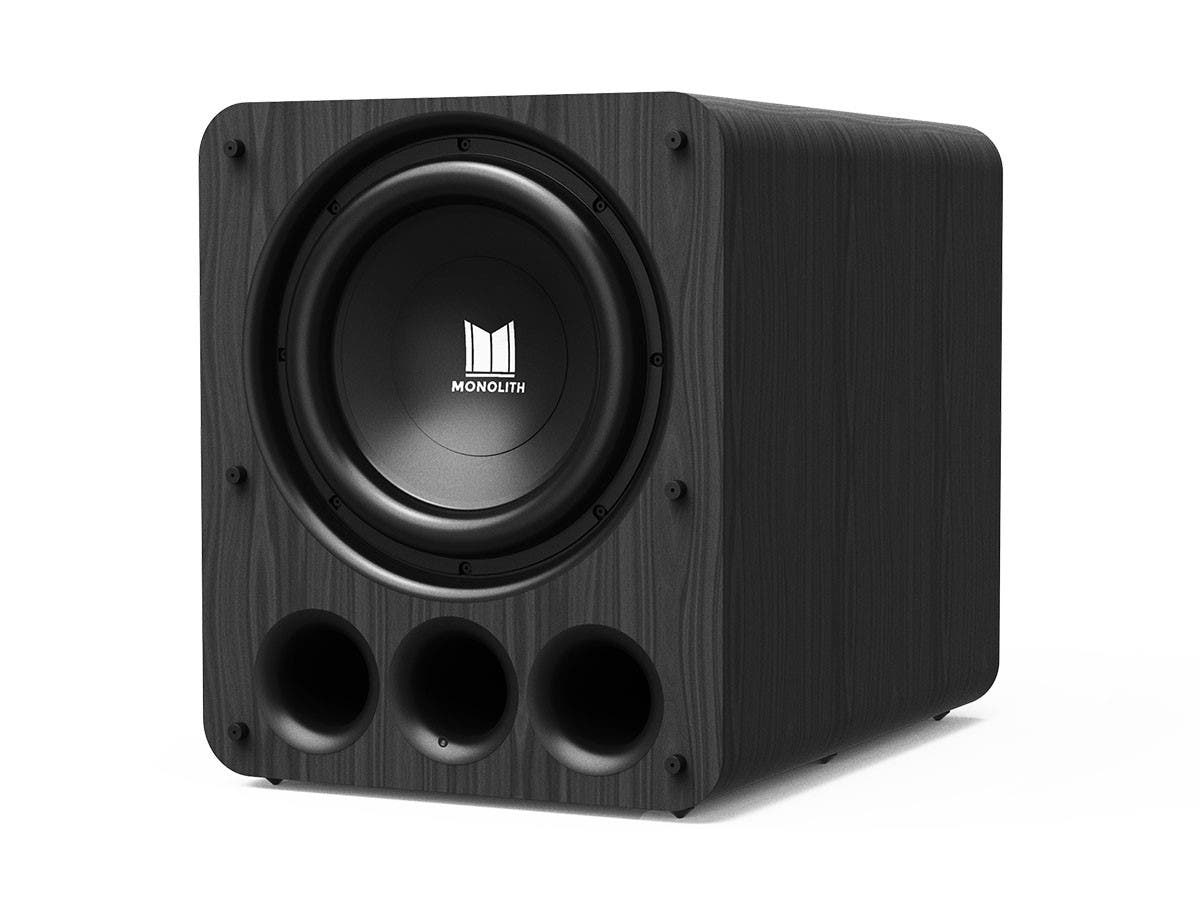




Similar threads